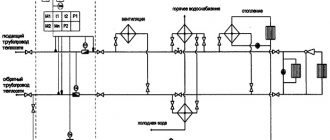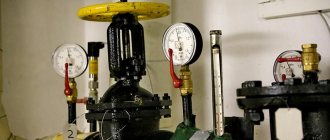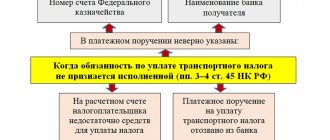There are situations when several, as if separate, apartment buildings have 1 resource meter installed:
- The houses are located on the so-called “coupling” (one house has a direct connection to the networks of the resource supply organization, and the houses following it have a sequential connection).
- The houses are part of a single complex, they have a lot in common, in addition to the meter, or the house consists of blocks (less often).
The Northwestern District is one of the richest in practice
► Resolution of the Arbitration Court of the North-Western District dated 07/04/2019 N F07-5432/2019 in case N A42-7017/2018 Satisfied the claim for debt collection for thermal energy, indicating that the volume of thermal energy should be determined on the basis of the commissioned and authorized a common building metering device, since an apartment building that is structurally managed represents a single building structure, although it has different postal addresses:
- Signs of the unity of an apartment building as a completed construction project may include unified in-house engineering and technical support systems and common areas.
- separate postal numbering of buildings is not a circumstance that certainly indicates that the buildings are separate apartment buildings.
The two buildings had common basic structural elements: a common load-bearing wall between the houses, a common foundation, enclosing and load-bearing structures, a roof, common in-house water supply and heating systems. The basement rooms had a through passage and were equipped with a single heating unit. Based on this, the courts came to the conclusion that the volume of thermal energy should be determined on the basis of a single metering device.
► Resolution of the Arbitration Court of the North-Western District dated October 19, 2017 N F07-10727/2017 in case N A42-5555/2016 The management organization tried to oblige resource workers to accept into operation the metering device for a commercial heat metering unit located in an apartment building.
She was refused:
the thermal energy metering unit determined the amount of thermal energy consumed by three separate buildings, namely two apartment buildings, as well as a non-residential building of a drug treatment clinic.
“At the same time, a metering device that records the consumption of thermal energy in several apartment buildings is not a common building metering device due to the concept used in clause 2 of the Rules for the provision of public utility services N 354, according to which a “collective (common house) metering device” is a measuring device (a set of measuring instruments and additional equipment) used to determine the volume (quantity) of the communal resource supplied to an apartment building...
The point of supply of thermal energy to an apartment building should be located on the external wall of the house at the junction of the intra-house heating system with external heating networks. Otherwise, it is possible to confirm the rights of the owners to heating networks located outside the external wall of this house. Moving the delivery point outside the external wall without the will of the owners means illegally placing the burden of maintaining property on persons who do not own this property, as well as the obligation to pay for heat losses in these networks.”
► Resolution of the Arbitration Court of the North-Western District dated October 3, 2019 N F07-9799/2019 in case N A56-135599/2018, amended by the ruling of the Supreme Court of the Russian Federation dated December 16, 2019 N 307-ES19-23434 The management organization managed the houses “on the link” , accrued according to the readings of a single counter. came from the housing inspection to calculate according to the standard. The court assessed the legality of such a requirement and found it correct
(though not immediately - only in the cassation court):
- the controversial heat energy meter does not meet the criteria of the ODPU in relation to the controversial MKD, since it takes into account the total consumption of several independent real estate objects and does not allow one to reliably determine the consumption of each object separately.
- each of the houses under consideration is individual in the composition and condition of the common property, engineering systems, and this metering device does not reflect the real amount of heat that is spent on heating each house.
- houses have different energy efficiency classes, which also indicates the impossibility of uniform distribution of heat consumption volumes.
- there is no evidence of the lack of technical capabilities to equip each apartment building with a thermal energy meter. On the contrary, a representative of the resource supplying organization in court acknowledged such a technical possibility and the possibility of disconnecting networks.
- the heating fee calculated according to the standards will be less than the fee calculated according to the readings of the disputed meter.
► The opposite position of the same court,
and also upheld in the Supreme Court of the Russian Federation - Resolution of the Arbitration Court of the North-Western District dated December 17, 2019 N F07-15448/2019 in case N A56-113924/2018, Determination of the Supreme Court of the Russian Federation dated April 14, 2020 N 307-ES20-3509 Dispute about recovery the debt from the owner of the premises ended in favor of the management organization.
The houses were “linked”, and the parties were just arguing about the possibility of using the readings of one meter if it was installed in relation to several houses. The owner insisted that in the absence of separate accounting for each house, the amount of thermal energy consumed for heating needs should be determined according to consumption standards. The management organization proceeded from the fact that since the Rules for the Provision of Public Utilities No. 354 do not regulate the procedure for determining the amount of resource allocated to several houses, the accounting of which, due to technological features, is carried out by one meter, then the readings of an existing meter can be used to determine the volume.
And the courts agreed with this position.
► Resolution of the Arbitration Court of the North-Western District dated October 31, 2019 N F07-11865/2019 in case N A42-10580/2017 Here, too, there was a dispute about the collection of debt for heat energy in the presence of one meter in relation to several consecutively connected apartment buildings. True, the homeowners association and the resource supplying organization were already arguing here. The partnership wanted to pay according to the meter, but the resource workers demanded from it according to the standard. The HOA won. The justification was similar to the decision from the previous case, plus clauses of the heat supply agreement were added, in which the parties prescribed resource metering using a meter. The courts refused to collect the debt from the resource supplying organization, calculated according to the standards, recognizing the legality of determining the volume of thermal energy based on the readings of the meter,
admitted into operation in the prescribed manner and having an unexpired verification period in the billing period.
In this case, the court even ordered an examination to find out whether it was technically possible to install a metering device in a second house without reconstruction, major repairs of existing and (or) creation of new in-house engineering systems. It turned out not. It also followed from the expert’s conclusion that the two apartment buildings “are structurally one building with a common foundation, a common internal load-bearing wall, a common heat supply system, heating, water supply, and one heating point.”
► Resolution of the Arbitration Court of the North-Western District dated 07/09/2018 N F07-7043/2018 in case N A56-66254/2017
The courts decided that the installation of an ODPU that takes into account the heat consumption of two or more houses does not contradict the law on energy conservation.
They recovered from the management company in favor of the resource supply organization the costs of installing such a lone meter.
The courts took into account that before filing the claim, the company did not raise any objections to the meter, transmitted its readings and calculated the amount of thermal energy consumed based on these readings.
► Ruling of the Third Cassation Court of General Jurisdiction dated December 25, 2019 N 88-2084/2019 A resident of St. Petersburg was denied a claim against the management organization, from which he demanded a recalculation of fees, citing the fact that there is no common house meter in the house, and utility bills Heating services should be determined based on the standard. The house was not equipped with a building-wide heat energy meter, since it did not have an independent input into the main intra-block network, which “prevents the installation of an individual heating point; it is “linked” with other apartment buildings, where a heating point and a heat energy metering unit are equipped, which carries out simultaneous accounting of heat consumption of all apartment buildings.” The payment was calculated in proportion to the area of residential buildings located “on the link,” which the courts considered legal. The decision also contained a reference to the letter of the Housing Committee dated 06.21.2013 N 2-1906/13, according to which the engineering system of multi-apartment buildings “on the link” is taken into account as a single engineering system of centralized heating of an apartment building, and the thermal energy consumption of several apartment buildings “ on the coupling" is taken into account by a single thermal energy metering unit for such houses,
Therefore, charging consumers for heating in such houses (“on a coupling”), calculating the payment for thermal energy must be done according to the readings of one meter.
The nuances of paying for common house metering devices
The payment amount is not distributed equally among all residents. Each payment for indicators occurs according to personal meters, depending on the size of the living space with allowances for maintenance. Commercial organizations also pay their ODPU in the receipt for the apartment separately from everyone else.
If the amount in the receipt appears to be overestimated, then you can submit a written application for a detailed explanation of the calculation formulas and the readings of general and personal meters. If the management company refuses to provide information, you must contact the prosecutor's office.
Calculation of non-residential premises
When calculating resource consumption, it is necessary to include in the cost of the area what belongs to all residents, regardless of personal metering devices.
Tariff calculation formula:
Rho = (P – P ind)*T, where:
- Ro - amount of payment for joint maintenance of places;
- R - total flow rate;
- Rind - the amount of energy resource consumption taken from individual metering devices;
- T – tariff size of a specific resource.
In order to encourage residents to purchase communal metering devices, the state uses tariff surcharges for persons who refuse to establish a general household metering device.
Please note: in addition to individual consumption of water, gas and electricity, the receipts include payment for general household expenses. This system is necessary to detect leaks in pipes from the organization supplying resources to the home.
Payment of receipts using the example of heating
To carry out calculations, special formulas have been developed in accordance with the availability of metering devices.
| Availability of equipment | Calculation example | Formula |
| Only a common house meter | Every month, the meter readings are divided by the total area of the entire building. Having received what was spent on 1 sq.m. the number of calories is multiplied by the heating tariff with the sum of the areas of the apartment with the adjacent share | Pi = Vd * x Si / Sob * T, where:
|
| General and individual metering devices | Used when it is possible to spread pipes horizontally (high-rise buildings). From the ODPU readings for heating, the total reading from all apartment meters is subtracted. Then the resulting value is increased by the share of each apartment and by the established tariff with heating charges. | Pi = ( Vin + Vi one * Si / Sob )*T), where:
|
| Lack of a personal meter in a separate apartment | ODPU readings are taken from all metering devices available in a particular apartment, minus the difference with the ratio of the common building meter, the resulting result is divided by the area of the entire house and multiplied by the sum of the area and the share of apartments without a meter. Only after this is multiplied by the heating cost per 1 cubic meter. m. | Pi = ( Vi + Si * ( Vd - ∑Vi ) / Sob)xT, where:
|
The amount of monthly deduction for the provision of services is the result of the formulas.
Thus, despite a number of disadvantages of ODPU and the forced nature of installation, it allows you to reduce the amount of resources consumed, thereby reducing the monthly expenses of an apartment building.
Central Federal District
► Appeal ruling of the Moscow Regional Court dated 10/07/2013 in case No. 33-21538/2013 The court declared illegal the prosecutor’s submission demanding a recalculation of fees in different buildings consuming resources through one meter:
“Residential buildings, taking into account the existing technical features of the design of their water supply and heat supply systems, represent a single object for providing the specified communal resources, and therefore the determination of fees for utilities provided for general house needs based on existing metering devices cannot be considered illegal.
Since the general meetings of the owners of premises in the buildings did not make a decision to install metering devices in each of the buildings,
the presence of existing unified water and heat meters obliges the company to charge for utilities provided for general house needs, based on the readings of these metering devices.”
► Resolution of the Arbitration Court of the Moscow District dated July 13, 2018 N F05-10546/2018 in case N A41-17904/2017 Several houses had one electricity meter, the payment for which arose in a dispute. The district court sent this case for a new trial: the parties did not agree on the amount of electricity, and the lower courts somehow dealt with it incorrectly, calculating the debt on the meter. During the review, it was necessary to establish the current scheme for organizing metering and technological connection and the validity of using meter readings for commercial metering purposes. The courts should have checked the defendant’s argument that a meter serving two houses at the same time is not an ODPU in relation to each of them
regardless of their location under the management of one organization and the implementation of energy supply under one contract. Upon re-examination, the accrual on the meter was denied.
Volga region
► Resolution of the Arbitration Court of the Volga District dated May 22, 2019 N F06-44989/2019 in case N A12-17137/2018 A standard story about the collection of debt for electricity according to the readings of 1 meter for a bunch of houses. The district court had to return the case for a new trial:
- The electricity control unit must be installed at the entrance to the apartment building.
- there is no evidence of the property owner making other decisions or agreeing with him on a different location for the metering device.
- The installation of one metering device to determine the volume of supplied utility resources in relation to several apartment buildings is not provided for by law.
- Thus, the inclusion in the contract of an energy supply point in an apartment building with the installation of one ODPU for many houses is contrary to the law and cannot serve as a basis for determining the volume of consumption for this device.
► Appeal ruling of the Saratov Regional Court dated May 29, 2018 in case No. 33-3382/2018 Here, the residents of the house sought and achieved that the payment be calculated according to the meter readings.
The meter was installed in their house, but also took into account the consumption of the neighboring house. The court took into account the lack of technical possibility of installing a metering device in each house without reconstructing the existing house and utility systems, which was confirmed by the inspection report. He also took into account that the disputed metering device was installed, put into operation, considered operational, not recognized as faulty, the deadlines for providing readings from the device were not violated, the check was carried out in a timely manner; The resource supplying organization, in disagreement with the installed metering device, did not take steps to equip houses with separate meters.
How are counting devices checked and maintained?
The operation of any meters involves the need for maintenance and monitoring of technical condition. If the technical condition of the device does not allow its use, the device should be replaced. This condition also applies to public meters.
The costs for performing the specified work are distributed among the residents of the apartment building, and organizational actions are distributed to the management company. Installation, maintenance and replacement of ODPU requires the contractor to have permits. The management company selects an organization that has the appropriate licenses and draws up contracts to perform the specified work.
Completed work is documented with appropriate acts that record the volumes closed to the contractor. During the inspection, the report notes any identified defects that require elimination. The act is signed by an authorized representative of the executing organization and, on the other hand, by an official of the management company.
The need to install communal metering devices is beyond doubt. Residents must take a responsible approach to making a decision on the need to use the DPPU, which will allow them to record the amount of resources spent on maintaining common property and minimize the cost of paying for them.
North Caucasus District
► Resolution of the Arbitration Court of the North Caucasus District dated 02/28/2020 N F08-8729/2018 in case N A53-21291/2017 A dispute over debt collection was also considered, and its amount was adjusted taking into account the illegality of using meter readings installed on many houses :
“The Court of Appeal rightfully rejected the applicant’s argument that the houses at the disputed addresses are a complex of buildings that act as one object and must be equipped with one metering device, as not corresponding to the case materials. From the presented technical passports and certificates from the MUPTiON it follows that the letters have independent areas of public places. Some letters indicate that there are no public areas.”
How are tariffs calculated for ODPU
In addition to the consumption of resources consumed directly to provide apartments and accounted for by individual meters, in any building there are places used by all residents - rooms for storing equipment, strollers, corridors, staircases and others.
We recommend: How to correctly calculate gas payments
Household devices for monitoring the resources used make it possible to calculate the cost indicators for the maintenance of such premises and the amount of the required payment.
To calculate such costs, the following formula is used:
Rho = (P – Rind)×T,
wherein:
- Rho – the estimated amount of payment for the maintenance of public places;
- P – total flow rate determined by ODPU;
- Rind is the total consumption of energy resources based on the readings of individual metering devices;
- T – the size of the tariff for the corresponding resources.
In order to interest residents in purchasing and using ODPU, the state, in addition to tariffs, provides for the use of increasing coefficients assigned to residents of buildings that do not have communal meters installed.
East Siberian District
► Resolution of the Arbitration Court of the East Siberian District dated March 12, 2020 N F02-842/2020 in case N A10-7508/2018 The Housing Inspectorate issued an order to the resource supply organization to ensure the commissioning of a common house thermal energy meter in a house of 4 sections (blocks). The resource supplying organization resisted, citing “the impossibility of commissioning the residential building due to the fact that the controversial building, consisting of four sections, is not a single apartment building; the blocks are detached townhouses and are not technically connected to each other.”
According to the organization, each block
“has its own separate input, therefore, an independent heating system;
their separate operation is possible.” However, the courts supported the inspectorate’s position on the unity of the sections of an apartment building as a public utility supply facility. They took into account the lack of evidence that the disputed heating system consists of four separate heating systems. From the presented diagram it follows that thermal energy is supplied through one input (elevator unit in a separate thermal chamber),
then the engineering system first branches into two branches, one of which runs to block A, and the second branches into 3 more branches leading to blocks B, C and D. Further, the courts suggested that the organization install several meters instead of one, if it insists so strongly on isolation of heating systems.
Who should pay for the installation of ODPU
At whose expense is the installation of ODPU in apartment buildings paid? Photo No. 2
Based on the information presented earlier, it became clear that all costs for installing the ODPU are borne by the homeowner. In the case where the house is private, the situation is extremely simple: he must contact the relevant companies in order to organize the installation of the necessary meters, and after the work is completed, pay for them.
However, what should residents of apartment buildings do?
In this situation, issues of payment and installation of DPPU are resolved in a slightly different way. Firstly, each owner of an individual apartment (or several owners) undertakes to pay for and organize the installation of meters specifically for their home. This practice is individual and is carried out in order to take into account resource consumption in a particular home.
Secondly, it is necessary to determine whether all residents of the apartment building agree to install a common meter. This practice is not mandatory, but after its implementation, all residents of the house will receive a number of privileges:
- full control of resource compliance with the norm;
- full control of the presence of any leaks on a general house scale;
- prevention of potential problems associated with leaks and other shortcomings with housing and communal services on a general building scale;
- the opportunity to significantly save on resources.
Payment for the installation of ODPU in apartment buildings is carried out on behalf of all homeowners by prior agreement and general collection of the necessary funds.







